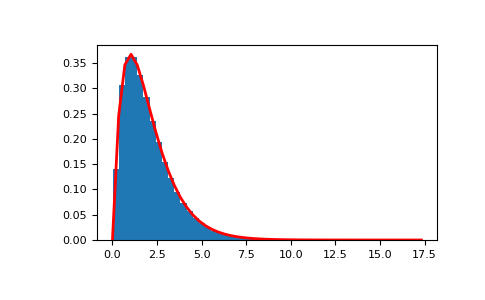numpy.random.Generator.standard_gamma#
方法
- random.Generator.standard_gamma(shape, size=None, dtype=np.float64, out=None)#
从标准伽马分布中抽取样本。
样本是从具有指定参数(形状参数(有时表示为“k”)和尺度参数 scale=1)的伽马分布中抽取的。
- 参数:
- shape浮点数或浮点数构成的类数组
参数,必须是非负数。
- size整数或整数元组,可选
输出形状。如果给定的形状是例如
(m, n, k),则会抽取m * n * k个样本。如果 size 为None(默认),则当shape是标量时,返回单个值。否则,抽取np.array(shape).size个样本。- dtype数据类型,可选
结果的期望数据类型,仅支持
float64和float32。字节顺序必须是本机字节序。默认值为 np.float64。- outndarray,可选
用于放置结果的备选输出数组。如果 size 不为 None,则其形状必须与提供的 size 相同,并且必须与输出值的类型匹配。
- 返回:
- outndarray 或 标量
从参数化的标准伽马分布中抽取的样本。
另请参阅
scipy.stats.gamma概率密度函数、分布或累积密度函数等。
注意
伽马分布的概率密度函数为
\[p(x) = x^{k-1}\frac{e^{-x/\theta}}{\theta^k\Gamma(k)},\]其中 \(k\) 是形状参数, \(\theta\) 是尺度参数,而 \(\Gamma\) 是伽马函数。
伽马分布常用于模拟电子元件的故障时间,并且自然地出现在与泊松分布事件之间等待时间相关的过程中。
参考文献
[1]Weisstein, Eric W. “Gamma Distribution.” 摘自 MathWorld–A Wolfram Web Resource。 https://mathworld.net.cn/GammaDistribution.html
[2]维基百科,“伽马分布”, https://en.wikipedia.org/wiki/Gamma_distribution
示例
从分布中抽取样本
>>> shape, scale = 2., 1. # mean and width >>> rng = np.random.default_rng() >>> s = rng.standard_gamma(shape, 1000000)
显示样本的直方图以及概率密度函数
>>> import matplotlib.pyplot as plt >>> import scipy.special as sps >>> count, bins, _ = plt.hist(s, 50, density=True) >>> y = bins**(shape-1) * ((np.exp(-bins/scale))/ ... (sps.gamma(shape) * scale**shape)) >>> plt.plot(bins, y, linewidth=2, color='r') >>> plt.show()
